Terpenes are the aromatic oils found in all plants. These molecules are responsible for the distinct smell and taste of cannabis varieties, and have an important role to play in the plant’s effects.
Research has found that the cannabinoid and terpene profile of a particular cannabis strain can help the consumer to predict the experience they might have – either uplifting or sedating – along with other therapeutic effects.
Terpenes may also hold their own pharmacologic importance as they seem to operate synergistically with cannabinoids, producing what is referred to as the entourage effect.
While the science behind cannabis is still a work in progress — and a fairly complex one at that — what we do know is that these tiny molecules that exist throughout the plant world have an important role to play into the therapeutic effects of most plant-derived foods and medicine.
Terpenes wheel: common cannabis terpenes
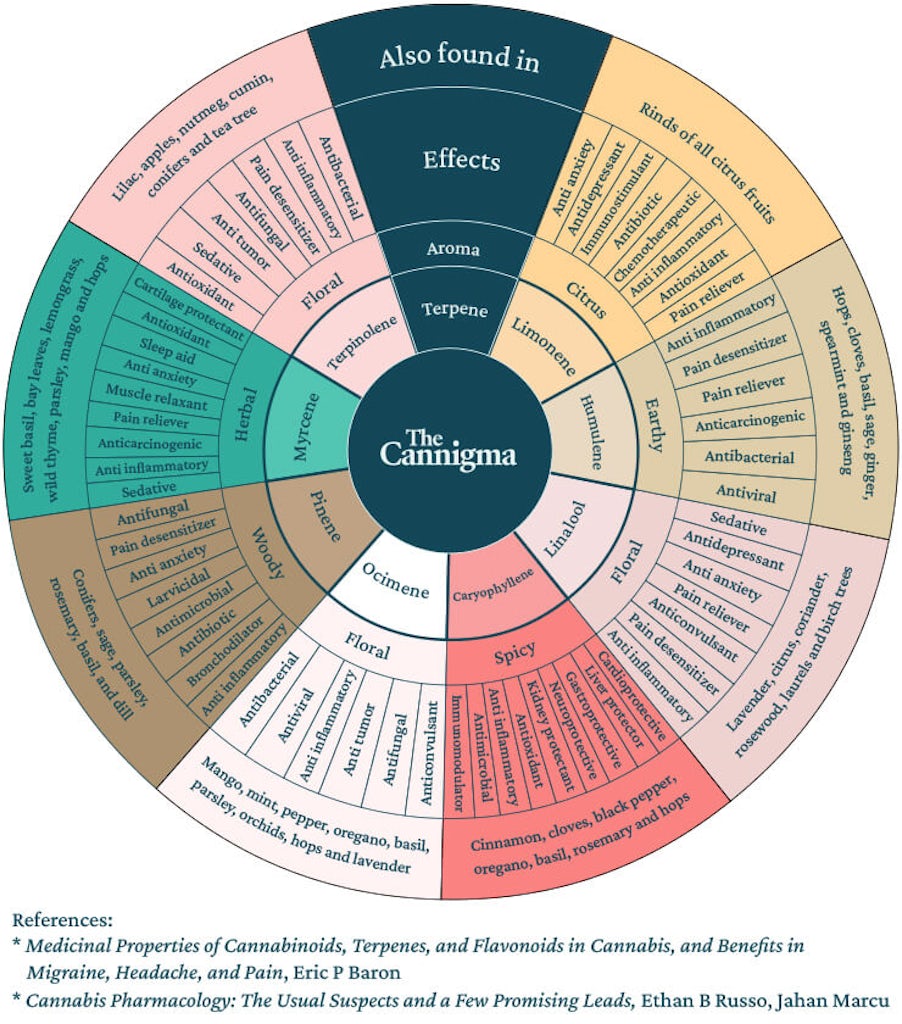
What are terpenes?
Terpenes were first identified in the 19th century and got their name from turpentine, a product made from pine tree resin that is rich in a terpene known as pinene. Terpenes can be found in all plants, and are abundant in most fresh fruits, flowers and vegetables. In fact, terpenes are the primary component of any “essential oil” and are also used all around the modern world, from flavoring ingredients to industrial cleaners. 1 2
Terpenes only recently rose to popularity among cannabis enthusiasts, but really, they’ve been around since the dawn of time. These molecules influence the smell and taste of different plants, and more importantly – they also serve ecological functions, such as protecting plants from predators, attracting pollinators and fighting fungi.
Defining terpenes
You may encounter the terms terpenoids, mono-terpenes, and sesqui-terpenes in terpene-related literature. The differences between these classifications are very minute and scientific, based on the chemical structure. For example, terpenes are made of hydrocarbons, specifically a five-carbon isoprene unit (C5H8).
These “units” may be combined in any number of ways, much in the same way as Lego building blocks. They are building blocks for the plant to create a vast number of chemicals and are essential to plant life.
If two units are combined you get a small smelly molecule like limonene. If you combine 8 isoprene units you get a larger molecule like lycopene. And if you combine millions of isoprene units you get a compound known as natural rubber latex–a very important industrial product used in everything from car tires to pairplanes to yoga mats. 3
The mono-, sesqui-, and di- prefixes relate to the number of isoprene units. Terpenoids are simply oxygen-containing terpenes. Sure, this might not mean much to the average toker, but the nomenclature helps us to further appreciate terpenes and their significance in the cannabis plant.
Terpenes and cannabis
Research indicates that terpenes, along with cannabinoids, determine two of the essential functions of cannabis:
- The type of high a chemovar (strain) may cause
- Which conditions it might help treat
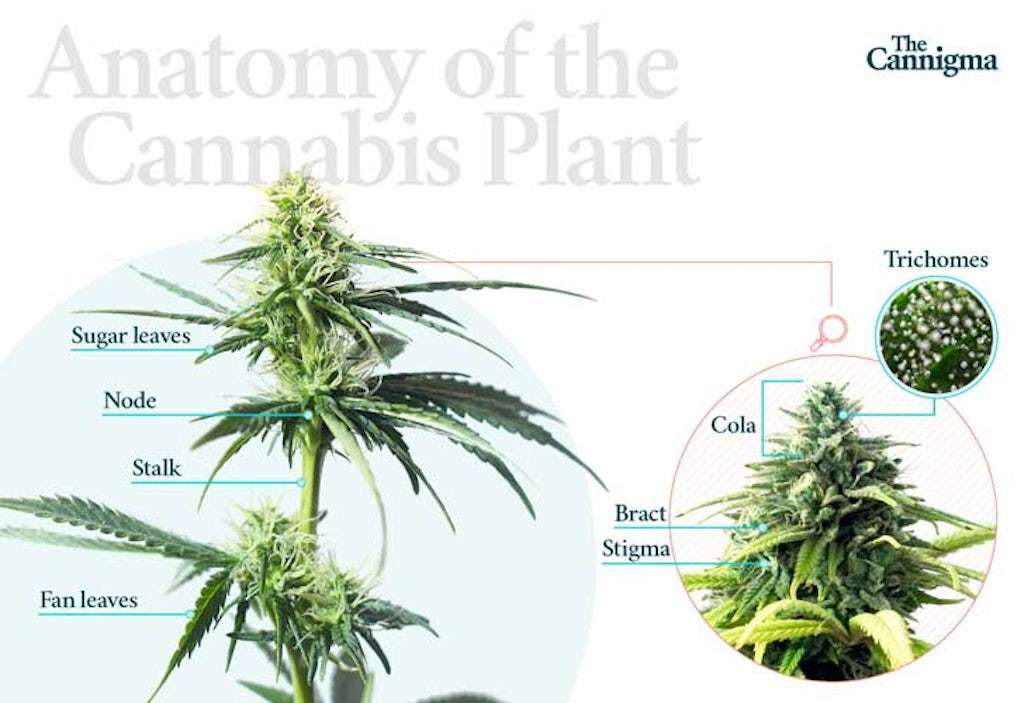
Terpenes are produced in tiny resin glands on the surface of the cannabis plant known as trichomes. These glands are very small and often can look like crystals or even dust to the naked eye. The trichome is also where cannabinoids are made in the plant, but each of these molecules have their own unique therapeutic potential.
While cannabis websites, and even some scientific studies, often cite that there are as many as 200 different terpenes found in cannabis, only about 50 of them are regularly encountered in North America and even fewer are regularly tested for. Of these, 17 are most common — these are listed below. 4
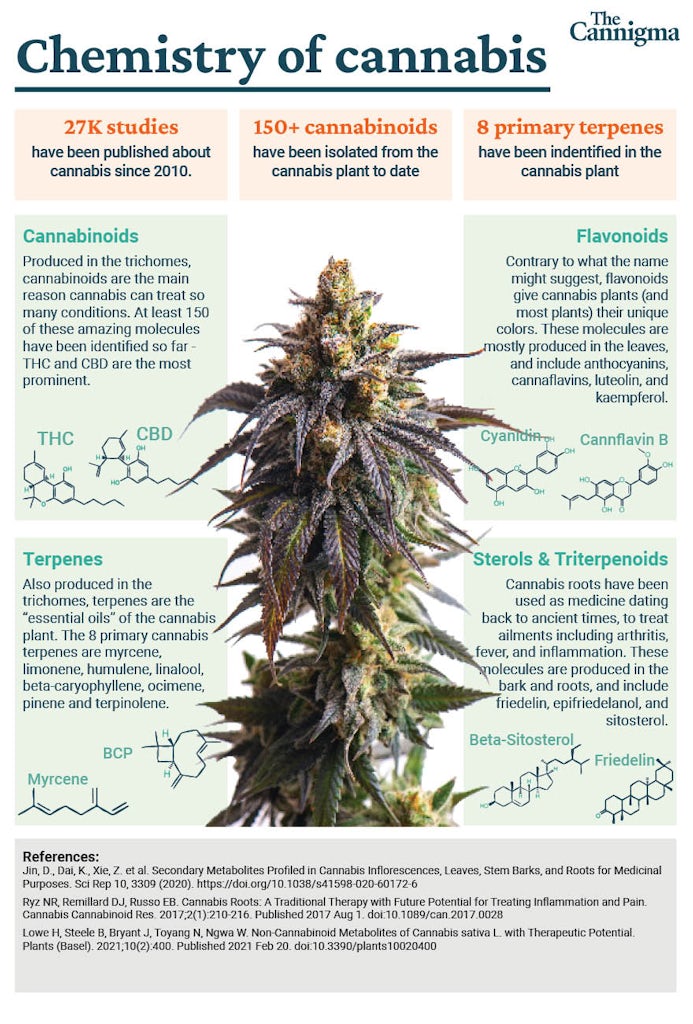
List of the most common cannabis derived terpenes
Knowing the properties of the major cannabis terpenes can be a powerful tool when choosing a cannabis product. Specifically, you’ll want to understand the main terpenes found in high concentrations in cannabis, their aroma, effects and potential therapeutic uses.
Most of the information below is based on two studies about cannabis constituents from 2017 and 2018. Though many terpenes are classified as Generally Regarded As Safe (GRAS) by the FDA, it’s important to note that this knowledge is mainly derived from non-cannabis focused research or cannabis research that based on animal models or in vitro (test-tube) studies. The GRAS list also only refers to the oral ingestion of these terpenes, not necessarily the inhalation of them or the inhalation of cannabis.
Myrcene

- Aroma: herbal
- Also found in: sweet basil, bay leaves, lemongrass, wild thyme, parsley, mango and hops
- Medicinal properties: sedative, anti inflammatory, anti carcinogenic, analgesic, muscle relaxant, anxiolytic and antioxidant
Also known as β-Myrcene (beta myrcene), Myrcene is the most common terpene in modern cannabis strains in the US and Europe. It is thought to be highly sedative and is suggested as the main responsible agent for the ”couch lock” effect in strains that produce a “physical, mellow, sleepy” high. In fact in Germany, myrcene-rich hops are used as a sleep-aid. It has also been suggested (but not confirmed) that myrcene increases permeation of the blood-brain barrier, allowing other cannabinoids and terpenes to pass through more easily. Myrcene has a herbal aroma, with musky and earthy notes. 5 6
Thanks to its medicinal properties, myrcene is suggested as a potential relevant treatment for conditions and symptoms such as:
BCP (beta-caryophyllene)
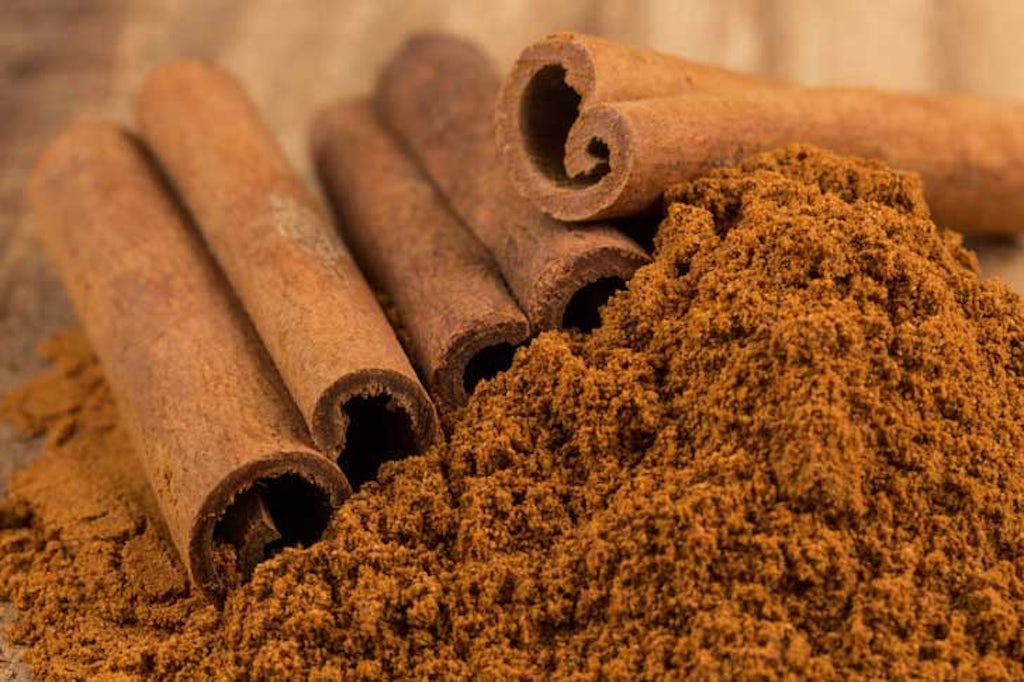
- Aroma: spicy
- Also found in: cinnamon, clove, black pepper, rosemary, oregano, basil and hops
- Medicinal properties: cardioprotective, analgesic, hepatoprotective, gastroprotective, neuroprotective, nephroprotective, antioxidant, anti inflammatory, antimicrobial, immunomodulator
Beta caryophyllene, aka caryophyllene or BCP, has a spicy aroma and is thought to be a relaxing and sedating terpene. It’s unique as a terpene because it also interacts with the body in a similar way to cannabinoids, via receptors in the endocannabinoid system, influencing its potential effects and therapeutic applications.
BCP shows potent anti-inflammatory effects and pain relieving properties in both inflammatory and neuropathic pain. Through its stimulation of the CB2 receptor, it is suggested to be effective for the following:
- inflammatory bowel diseases (crohn’s/ulcerative colitis)
- Parkinson’s disease
- dementia
- anxiety
- depression
Interestingly, unrelated to the ECS, BCP has shown potential in the treatment of alcohol and cocaine abuse. And if all that isn’t enough, it’s also considered to be a potent anticancer agent.
Read more about beta-Caryophyllene
Pinene
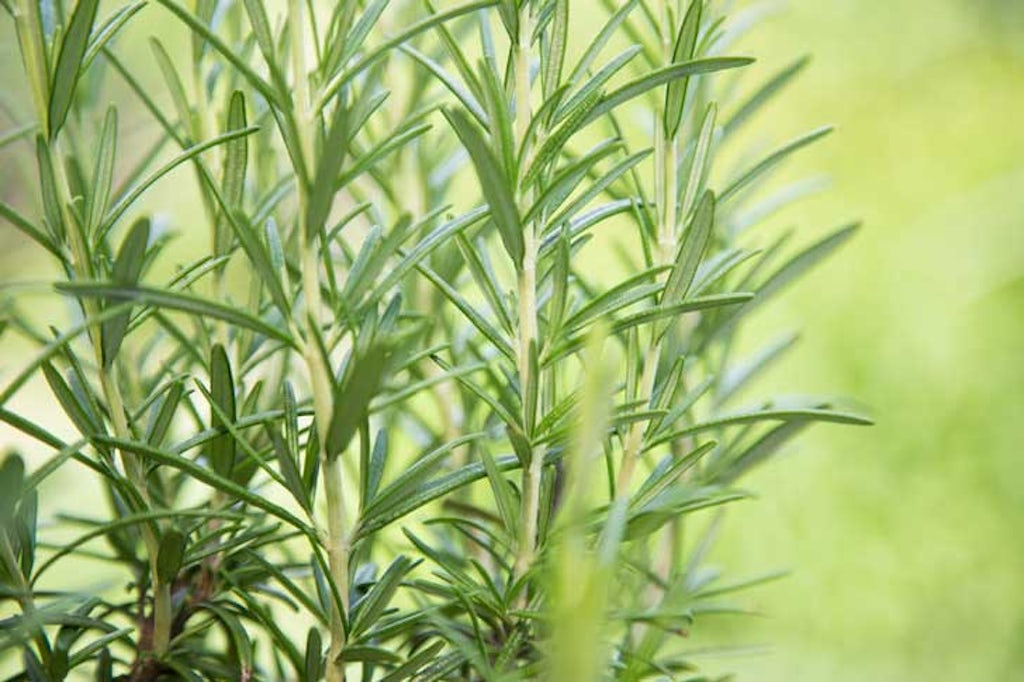
- Aroma: woody
- Also found in: pine trees, parsley, rosemary, dill and sage
- Medicinal properties: anti inflammatory, bronchodilator, antibiotic, anxiolytic and analgesic
There are two main types of pinene, alpha and beta, but alpha pinene is more abundant in cannabis. It has a woody aroma and can be found in large amounts in the resin of conifer trees such as pines (hence the name). Interestingly, pinene can potentially help with the short term memory loss associated with THC.
It’s also suggested as a potential treatment for conditions and symptoms such as
- arthritis
- dementia
- asthma
- SARS
- acne
- cancer (particularly neuroblastoma, melanoma, and hepatic carcinoma)
Ocimene
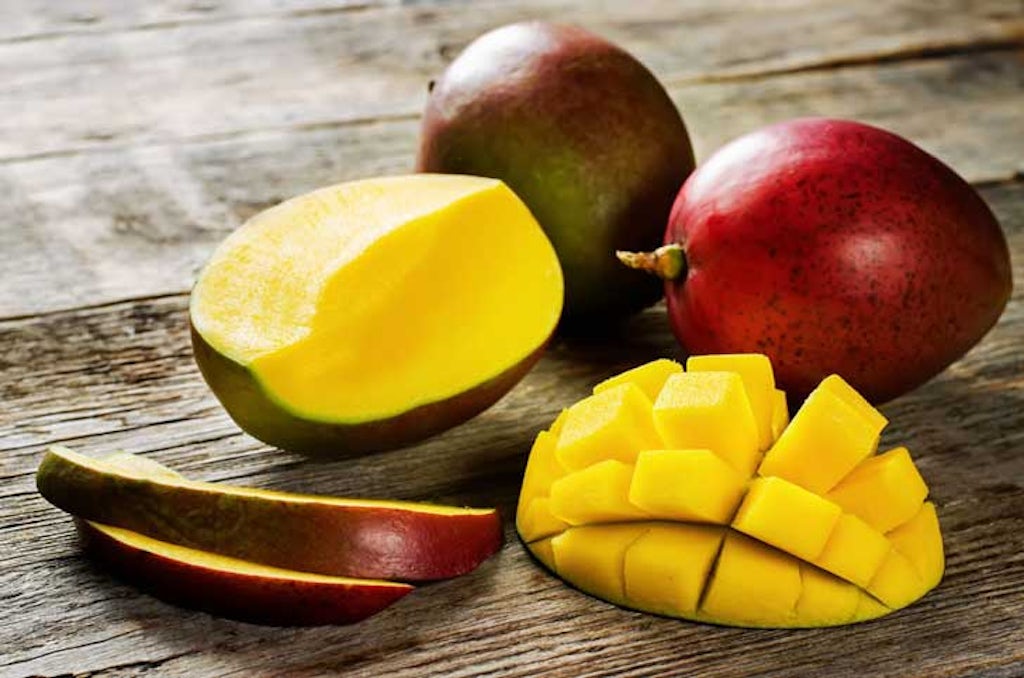
- Aroma: floral
- Also found in: pepper, mango, mint, oregano, basil, parsley, celery leaf, tarragon and lavender
- Medicinal properties: anticonvulsant, antiviral, anti inflammatory, antitumor and antifungal properties
Ocimene has a fresh, floral aroma with woody notes, and is suggested as a potential use in seizure-related conditions such as epilepsy, inflammation and different types of cancer. Ocimene is also used in honey bee colonization to regulate social interactions of bees.
Don’t be surprised if you’ve heard it mentioned a time or two with respect to “cannabis honey,” however this lies on the assumption that the bees collect resin from the plant instead of nectar.
Humulene
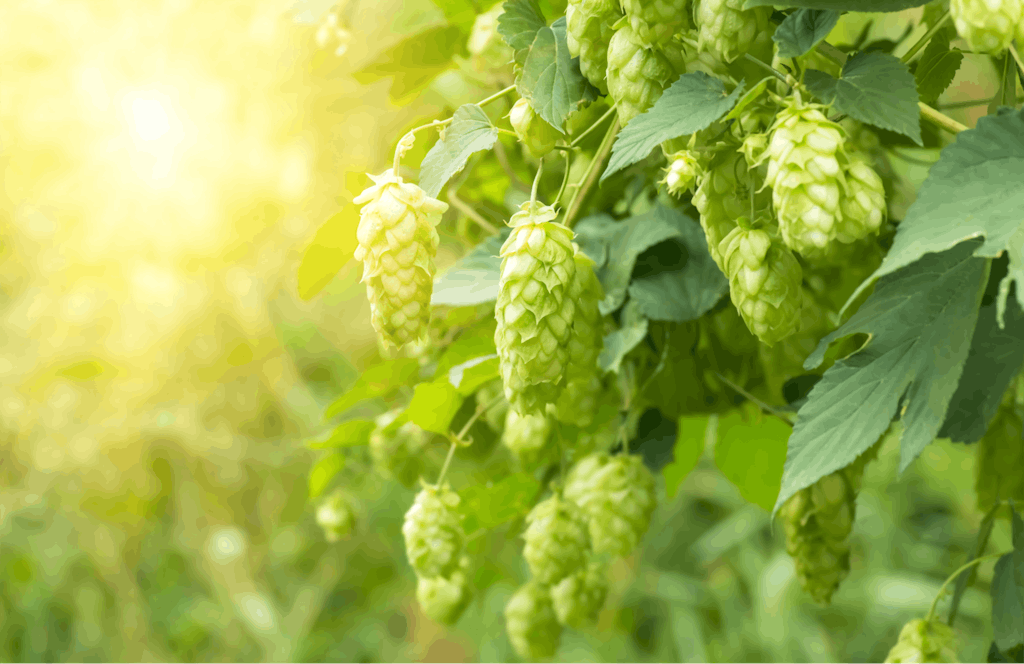
- Aroma: earthy
- Also found in: coriander, ginger, sage, clove, l, spearmint and ginseng, and found in high concentrations in hops (humulus lupulus)
- Medicinal properties: anti inflammatory, anti carcinogenic, analgesic, antibacterial and antiviral
Humulene is closely related to BCP from a molecular point of view (its original name is actually alpha-caryophyllene), and actually might perform better when in the presence of BCP – further supporting the entourage effect theory. Its aroma is often described as earthy and woody, sometimes associated with the “hoppy” aroma of beer. It is found in high concentrations in hops (humulus lupulus), from which its name is derived. Additionally the hops plant is a close cousin of the cannabis plant as both are part of the cannabaceae family, so the fact that they both produce humulene, beta-caryophyllene, and myrcene is of little surprise.
Humulene is considered to be a strong anti-inflammatory and analgesic agent, suggesting potential benefits for both local and systemic pain (especially inflammatory pain). It also showed anticancer activity in preliminary research, and there are some anecdotal reports of appetite suppression and weight loss, which could greatly affect obesity and metabolic conditions.
Terpinolene

- Aroma: floral
- Also found in: apples, pines, turmeric leaf, sage and cardamon, but it’s most abundant in parsnip
- Medicinal properties: sedative, antioxidant, antiproliferative, , cardioprotective, analgesic and anti inflammatory.
Terpinolene is often considered to have a floral aroma with a twist of citrus and earthy fragrance. Though sedative in mice, subjective consumer reports suggest that cannabis varieties rich in terpinolene are actually stimulating in humans. The combination of THC and terpinolene might be the reason for this inconsistency. In cannabis, terpinolene is present in many varieties, mostly sativa-dominant ones, but usually in low concentrations.
It’s thought to be of potential value for conditions such as
- hypertension
- pain (especially inflammatory)
- cancer (particularly neuroblastoma and chronic myelogenous leukemia)
Linalool
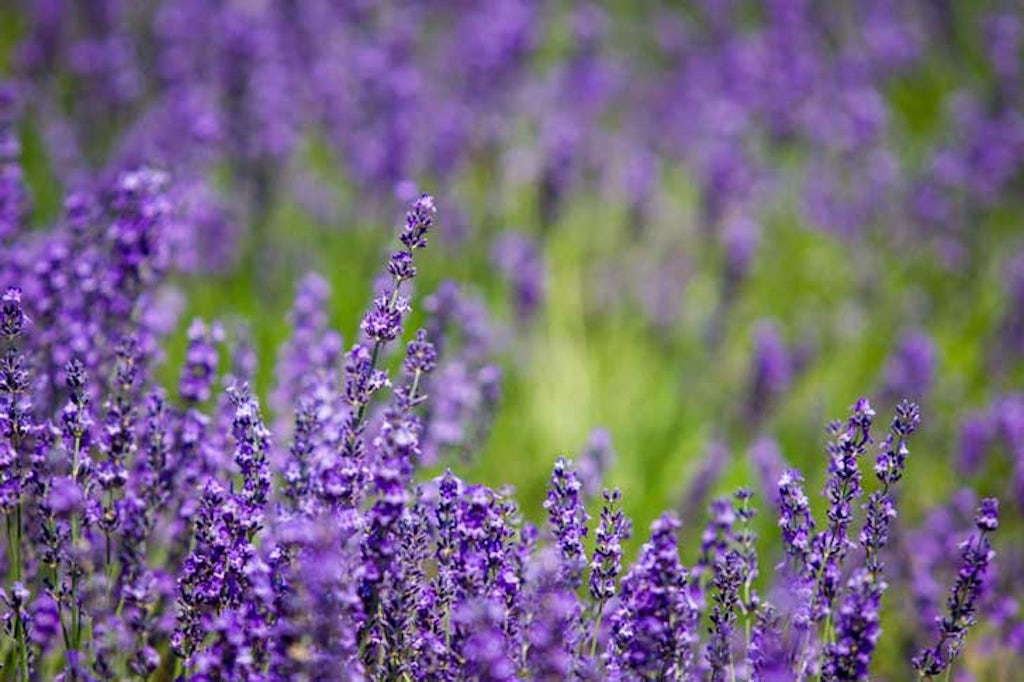
- Aroma: floral
- Also found in: lavender, roses, basil, laurels and cinnamon
- Medicinal properties: anti inflammatory, anticonvulsant, relaxant, analgesic, sedative, anti depressant, and anxiolytic agent
Though present in a lot of spices and flowers, particularly high concentrations of linalool can be found in lavender. It’s no surprise that lavender is commonly used in spa and relaxation practices due to it’s calming nature.
However, this floral and spicy terpene has a long list of medical effects that suggest a potential application for conditions and symptoms such as:
- anxiety
- stress
- depression
- insomnia
- pain
- seizures
Limonene

- Aroma: citrus
- Also found in: the rinds of all citrus fruits
- Medicinal properties: anxiolytic, antidepressant, antibiotic, chemotherapeutic, anti inflammatory, analgesic and immune stimulant
As suggested by the name, limonene (aka D-limonene) has a citrus aroma and can be found in high concentrations in the rinds of citrus fruits. This terpene is believed to be responsible for the“cerebral and euphoric” experience, commonly attributed to some cannabis chemovars. It is also believed to be a permeation enhancer for oral and topical products that are produced with nano-emulsion technology. 7 8 9
Limonene has been suggested as a potential treatment for a myriad of conditions and symptoms, such as:
- multiple sclerosis
- IBD (crohn’s/ulcerative colitis)
- GERD
- anxiety
- depression
- inflammation
- pain
- asthma
- obesity
- arthritis
- cancer (particularly skin, breast, prostate and glioblastoma)
It may also be helpful for Parkinson’s disease due to its antioxidant and neuroprotective properties, but this is yet to be researched.
Other common terpenes in North American chemovars (strains):
Camphene
- Also found in: turpentine, camphor oil, citronella oil, ginger oil, cypress oil and valerian
- Medicinal properties: antifungal, analgesic, antioxidant
Beta-pinene
- Also found in: pine trees, parsley, rosemary, dill and basil
- Medicinal properties: antibiotic
Alpha- phellandrene
- Also found in: frankincense, ginger, cinnamon, parsley, lavender, eucalyptus, water fennel and grand fir
- Medicinal properties: analgesic, anti depressant
Delta 3 Carene
- Also found in: pine trees, white pepper, cedar, basil
- Medicinal properties: anti inflammatory, antifungal
Alpha terpinene
- Also found in: tea tree oil
- Medicinal properties: antiparasitic, antioxidant
Gamma-terpinene
- Also found in: eucalyptus, cumin
- Medicinal properties: antifungal, antioxidant, anti-inflammatory
Fenchol
- Also found in: basil
- Medicinal properties: antioxidant, antibacterial
Terpineol
- Also found in: pine trees, lime blossoms, eucalyptus and lilacs
- Medicinal properties: Sedative, anxiolytic, analgesic, anti inflammatory, antiproliferative, antioxidant, anti carcinogenic, antibacterial, antifungal and antiviral
Caryophyllene oxide
- Because it is the natural degradation product of BCP, it’s also found in plants high in BCP like: rosemary, lavender, cloves, hops, lemon balm, basil, oregano, black pepper and eucalyptus
- Medicinal properties: analgesic, anti inflammatory
Concentration of terpenes in cannabis
In the early 2000s the research traditionally found the total terpene concentration in cannabis flowers to be about 1%, which is quite low compared to cannabinoids that usually make up an average of 15-20%. But selective breeding has increased concentrations to as high as 4.8%, as shown in studies from recent years. 10
These low concentrations of individual terpenes, often much lower than 1%, might give the impression of irrelevance, but unlike cannabinoids, terpenes appear to be effective at concentrations above 0.05%. 11
Why terpenes are crucial in cannabis: whole plant vs isolated products
To understand how terpenes work in cannabis and why such low concentrations are effective, let’s first look at whole plant therapy, and more particularly at the entourage effect theory.
This theory is based on the known notion that, in some cases, whole plant products are more effective than their isolate derivatives. This concept isn’t backed by a lot of experimental evidence, but this is gradually changing. When it comes to cannabis, cannabis expert Dr. Ethan Russo suggests that major cannabinoids such as THC and CBD are influenced by each other, but also by terpenes and other minor cannabinoids that are present in much lower concentrations.
How cannabis terpenes affect you

It has been long held in cannabis pop culture that what gives cannabis cultivars their unique properties are their sativa or indica genetics — sativa as uplifting and indica as sedating — but science has gradually shed light on the complexity of the issue. In fact, the entire chemical profile determines how cannabis affects us, and more specifically the concentrations of specific cannabinoids and terpenes.
The role of terpenes in this is twofold: on the one hand they influence the type of “high” or intoxication you’ll experience. Some terpenes such as myrcene and linalool are more sedative, while limonene and pinene for instance, are associated with uplifting effects.
Secondly, terpenes may influence the efficacy of specific cultivars for different medical conditions. Some are anti-inflammatory (such as myrcene and BCP), others can be anxiolytic (linalool and limonene), and others are anticarcinogenic (limonene and ocimene). But it’s important to note that the jury’s still out when it comes to their combined effects.
For now, cannabis patients and recreational users can look at the research for each terpene, and test different combinations until they find the perfect chemical variation. For instance, when treating seizures, you can narrow down the possibilities, and test cultivars that are dominant in linalool or ocimene, which show anticonvulsant properties.
This might not be the traditional way to find treatment, and knowledge is indeed lacking when it comes to how the entourage effect works exactly, but one thing is clear: clinical evidence of the superiority of whole plant treatments over isolated CBD or THC is piling up. 12
Medicinal properties of terpenes
More than 55,000 terpenes have been identified in nature, and new ones are being discovered on a regular basis. Along with smells and tastes, terpenes have also been shown to have anti-bacterial, anti-inflammatory, analgesic, anti-depressant, and anticonvulsant properties, among others.
While clinical research is severely lacking, terpenes are the most important compounds in essential oils, which were used by ancient civilizations such as China, India and Egypt for aromatherapy.
Though essential oils and aromatherapy have been long considered as alternative medicine, it’s clear that terpenes are biologically active, and are gradually gaining legitimacy in the scientific community as therapeutic agents.
Sources
- Baser, K. H. C., & Buchbauer, G. (2015). Handbook of Essential Oils: Science, Technology, and Applications, Second Edition. CRC Press.
- Omar J, Olivares M, Alonso I, Vallejo A, Aizpurua-Olaizola O, Etxebarria N. Quantitative Analysis of Bioactive Compounds from Aromatic Plants by Means of Dynamic Headspace Extraction and Multiple Headspace Extraction-Gas Chromatography-Mass Spectrometry. J Food Sci. 2016;81(4):C867-C873. doi:10.1111/1750-3841.13257
- Pichersky, E. and Raguso, R.A. (2018), Why do plants produce so many terpenoid compounds?. New Phytol, 220: 692-702. https://doi.org/10.1111/nph.14178
- Lewis MA, Russo EB, Smith KM. Pharmacological Foundations of Cannabis Chemovars. Planta Med. 2018;84(4):225-233. doi:10.1055/s-0043-122240
- Russo EB. Taming THC: potential cannabis synergy and phytocannabinoid-terpenoid entourage effects. Br J Pharmacol. 2011;163(7):1344-1364. doi:10.1111/j.1476-5381.2011.01238.x
- Surendran S, Qassadi F, Surendran G, Lilley D, Heinrich M. Myrcene-What Are the Potential Health Benefits of This Flavouring and Aroma Agent?. Front Nutr. 2021;8:699666. Published 2021 Jul 19. doi:10.3389/fnut.2021.699666
- Hamada M, Uezu K, Matsushita J, Yamamoto S, Kishino Y. Distribution and immune responses resulting from oral administration of D-limonene in rats. J Nutr Sci Vitaminol (Tokyo). 2002;48(2):155-160. doi:10.3177/jnsv.48.155
- Sakeena MH, Elrashid SM, Muthanna FA, et al. Effect of limonene on permeation enhancement of ketoprofen in palm oil esters nanoemulsion. J Oleo Sci. 2010;59(7):395-400. doi:10.5650/jos.59.395
- Russo, E. B., & Marcu, J. (2017). Cannabis Pharmacology: The Usual Suspects and a Few Promising Leads. Advances in pharmacology (San Diego, Calif.), 80, 67–134. https://doi.org/10.1016/bs.apha.2017.03.004
- Lewis, M. A., Russo, E. B., & Smith, K. M. (2018). Pharmacological Foundations of Cannabis Chemovars. Planta medica, 84(4), 225–233. https://doi.org/10.1055/s-0043-122240
- Russo E. B. (2011). Taming THC: potential cannabis synergy and phytocannabinoid-terpenoid entourage effects. British journal of pharmacology, 163(7), 1344–1364. https://doi.org/10.1111/j.1476-5381.2011.01238.x
- Russo E. B. (2019). The Case for the Entourage Effect and Conventional Breeding of Clinical Cannabis: No “Strain,” No Gain. Frontiers in plant science, 9, 1969. https://doi.org/10.3389/fpls.2018.01969
Sign up for bi-weekly updates, packed full of cannabis education, recipes, and tips. Your inbox will love it.

 Shop
Shop Support
Support


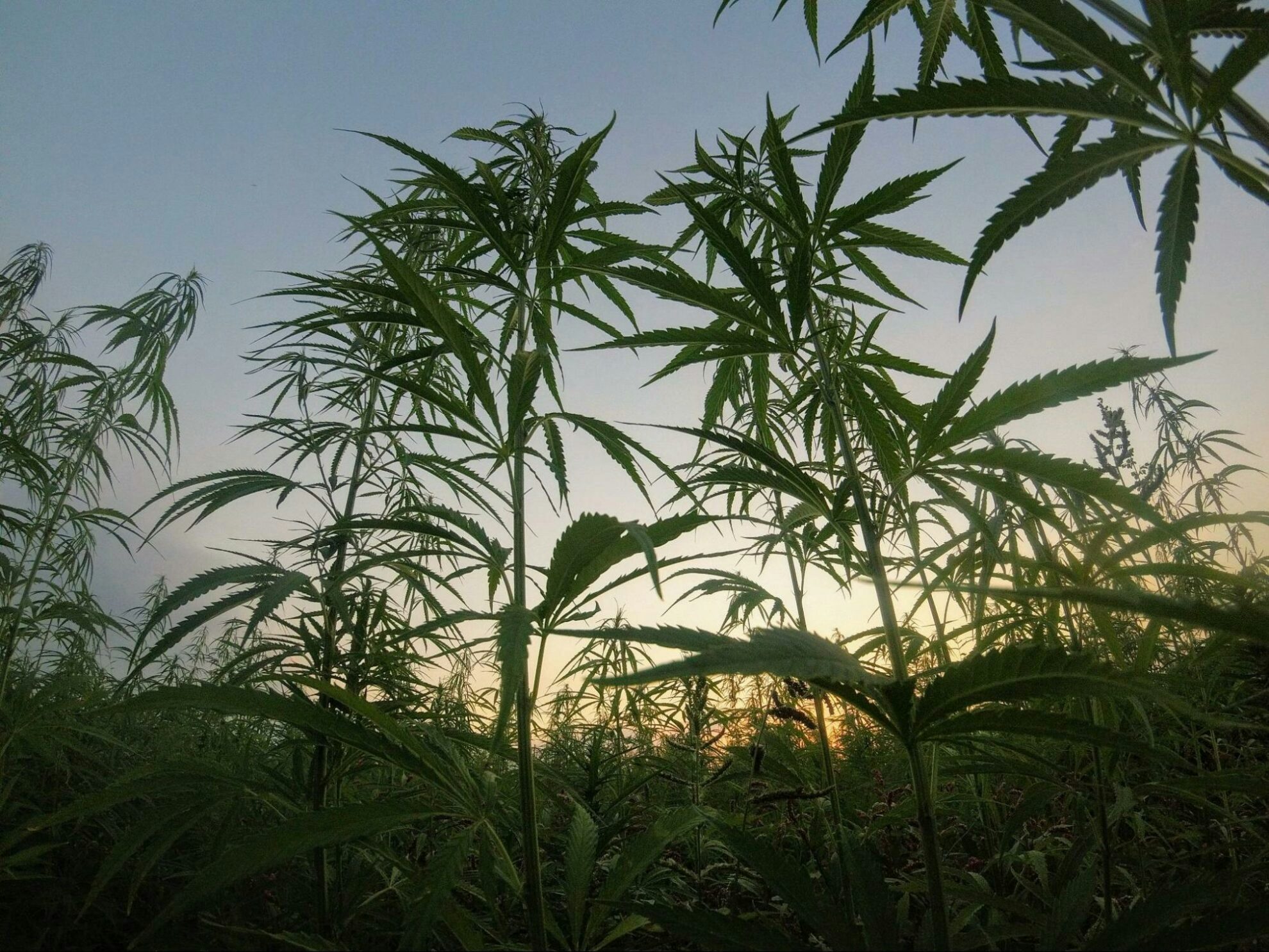



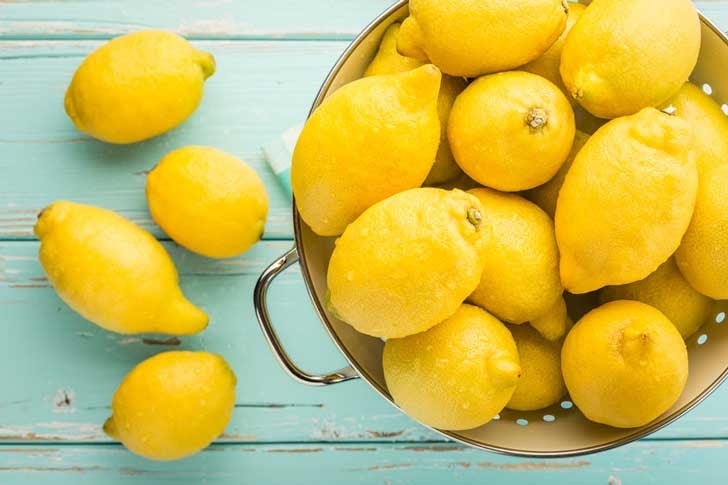












I really like your website, I have PTSD & Depression & was able to see which strains will help my medical problems the best